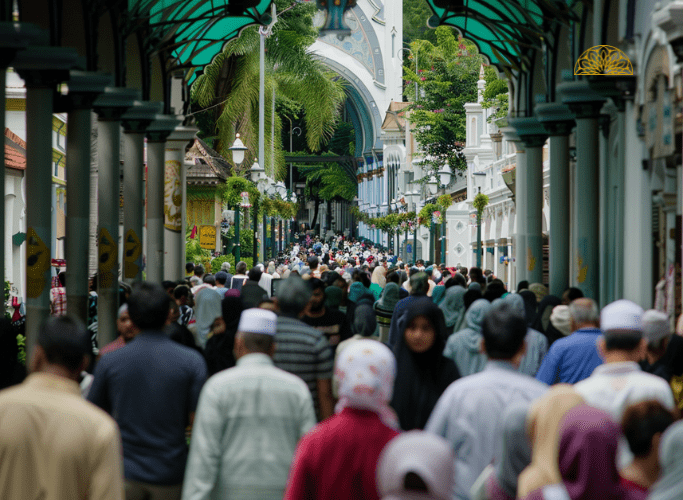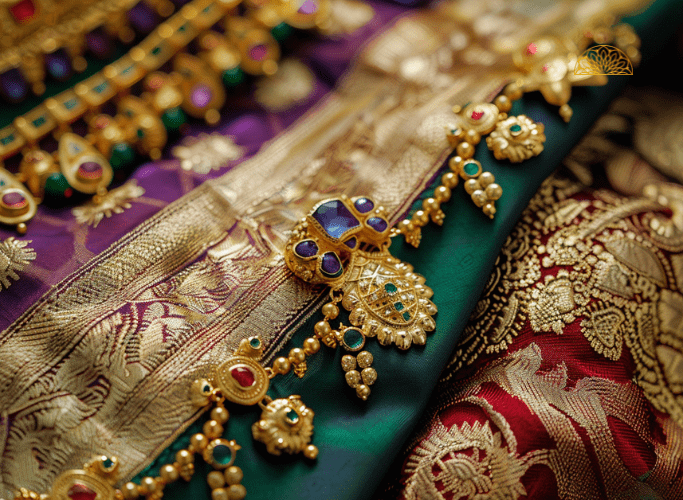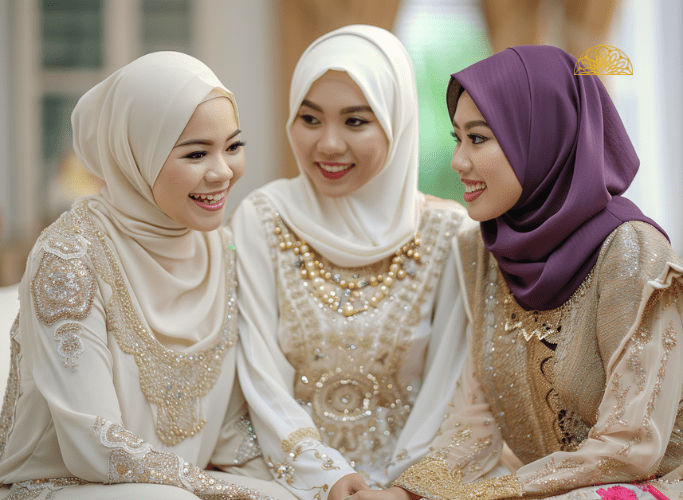Singapore is a city-state known for its vibrant multicultural society. The fusion of cultures is evident in various aspects of daily life, including traditions and celebrations. One such celebration is Hari Raya, which marks the end of Ramadan for Muslims. Hari Raya, or Eid al-Fitr, is a significant occasion for families to celebrate and exchange gifts. Among the cherished traditions of Hari Raya is the adornment of jewellery, which reflects the rich influences of Malay and Islamic cultures.

Understanding the Cultural Fusion in Singapore
To truly appreciate the beauty and significance of Hari Raya jewellery, it is important to understand the cultural fusion that exists in Singapore. The city-state has a diverse population, with Malays making up a significant portion of the community. The Malay culture, which has roots in the region’s indigenous people, is influenced by a combination of Indian, Chinese, and Arab traditions. This unique blend is further enriched by the Islamic values and practices brought by the Muslim settlers.
Singapore’s cultural fusion extends beyond just the Malay and Islamic influences. The country’s history as a British colony has also left a lasting impact on its cultural landscape. British colonial architecture can still be seen in parts of Singapore, blending seamlessly with the modern skyscrapers that dominate the skyline. This mix of old and new reflects the country’s ability to embrace diverse influences while forging its own identity.
The Unique Blend of Malay and Islamic Cultures
The fusion of Malay and Islamic cultures in Singapore results from centuries of interactions between different ethnic communities. Over time, traditional Malay jewellery-making techniques have been infused with Islamic-inspired designs, resulting in a distinctive style unique to the region. This blend reflects the harmonious coexistence of various cultural influences in Singapore.
Furthermore, the influence of Malay and Islamic cultures can also be seen in Singapore’s culinary scene. Dishes like Nasi Lemak and Satay have become popular staples that people of all backgrounds enjoy. The use of aromatic spices and rich flavours in Malay and Islamic cooking reflects the diversity and vibrancy of Singapore’s food culture.
The Influence of Cultural Fusion on Singapore’s Traditions
Singapore’s cultural fusion has profoundly impacted local traditions, including those related to Hari Raya. The celebration of Hari Raya is an occasion for Malays to showcase their cultural heritage and pay homage to their Islamic beliefs. The fusion of cultures is evident in the choice of jewellery, which incorporates traditional Malay motifs and Islamic symbolism.

The Significance of Jewellery in Hari Raya Celebrations
In Malay culture, jewellery holds immense significance, and this is particularly true during Hari Raya. Jewellery is often passed down through generations, symbolising family heritage and tradition. Wearing jewellery during Hari Raya is believed to bring good luck and ward off evil spirits. Additionally, jewellery serves as an expression of personal style and status.
During Hari Raya celebrations, the intricate designs and craftsmanship of the jewellery play a crucial role in enhancing the traditional attire worn by both men and women. Women often adorn themselves with elaborate necklaces, bangles, and earrings, while men opt for more understated yet elegant accessories like rings and cufflinks. Each piece of jewellery carries its own story and significance, adding depth to the overall festive attire.
The Role of Jewellery in Malay Culture
In Malay culture, jewellery is integral to a woman’s identity. It is worn during special occasions, including weddings and religious festivals like Hari Raya. The intricately crafted designs and use of precious materials reflect the attention to detail and craftsmanship highly valued in Malay culture.
Furthermore, selecting and wearing jewellery during Hari Raya is steeped in tradition and symbolism. Families often gather to share stories behind heirloom pieces, reinforcing the bonds between generations. Adorning oneself with jewellery is a way to honour ancestors and carry forward their legacy, creating a sense of continuity and connection to the past.
Islamic Influences on Hari Raya Jewellery Designs
Islamic influences are also reflected in the designs of Hari Raya jewellery. Islamic motifs, such as the crescent moon and star, are often incorporated into the designs as symbols of faith. Additionally, calligraphy inscribes religious verses on jewellery, adding a spiritual element to the pieces.
The fusion of Islamic artistry with traditional Malay craftsmanship results in jewellery pieces that enhance the wearer’s beauty and serve as a visual representation of cultural and religious harmony. Each design element is carefully chosen to reflect the values of unity, faith, and heritage, creating a unique blend of aesthetics synonymous with Hari Raya celebrations.

The Artistry Behind Hari Raya Jewellery
Hari Raya jewellery is a testament to the skill and artistry of the craftsmen who create them. Traditional techniques passed down through generations craft intricate and delicate pieces. These techniques include filigree work, where fine wires are twisted and soldered to create elaborate patterns.
Delving deeper into the artistry behind Hari Raya jewellery unveils a world of rich cultural significance and meticulous craftsmanship. Each piece is a mere adornment and a reflection of the artisan’s dedication to preserving traditional techniques and heritage.
Traditional Techniques in Jewellery Making
Traditional Malay jewellery-making techniques involve intricate metalwork, often using gold and silver. Skilled artisans meticulously shape and solder the metal to create stunning filigree patterns or intricate engravings. The result is a piece of jewellery that is beautiful and tells a story of the cultural heritage.
The intricate patterns found in Malay jewellery are often inspired by nature. Motifs such as flowers, leaves, and geometric shapes symbolise various aspects of life and beliefs. These designs are not just decorative but carry deep meanings that resonate with wearers and admirers alike.
Modern Interpretations of Classic Designs
While traditional techniques are still highly valued, contemporary artisans explore innovative approaches to Hari Raya jewellery. Modern interpretations of classic designs incorporate elements of minimalism and experimentation with materials. This blend of traditional and modern aesthetics appeals to the younger generation and those who appreciate a more contemporary style.
Contemporary Hari Raya jewellery designers are pushing boundaries by incorporating sustainable practices and ethically sourced materials into their creations. By embracing eco-friendly initiatives, these artisans are producing exquisite pieces and contributing to a more sustainable and responsible future for the jewellery industry.

The Symbolism in Hari Raya Jewellery
Hari Raya jewellery is a fascinating reflection of Malaysia’s rich cultural tapestry. Each piece is intricately woven with symbolism that transcends mere aesthetic beauty. Beyond being mere adornments, these pieces carry a profound significance, often embodying cultural values and beliefs that have been passed down through generations.
The craftsmanship involved in creating Hari Raya jewellery is a testament to the skilled artisans who meticulously bring these symbolic pieces to life. From intricate designs to delicate detailing, each element is carefully crafted to convey a deeper meaning that resonates with the wearer and onlookers alike.
The Meaning Behind Common Motifs
Delving into the world of Hari Raya jewellery unveils a treasure trove of symbolism embedded within common motifs. For instance, the Bunga melon, or jasmine flower, symbolises purity and beauty in Malay culture. This delicate flower adds a touch of elegance to the jewellery and serves as a poignant reminder of the values cherished by the community. Similarly, the keris, a traditional Malay dagger, is not just a decorative element but a powerful symbol of courage and protection, embodying the spirit of resilience and strength.
Exploring the intricate details of these motifs reveals a deeper narrative woven into each piece of jewellery, making them not just accessories but storytellers of tradition and heritage.
The Significance of Materials and Colours
Materials and colours play a pivotal role in the symbolism of Hari Raya jewellery, adding layers of meaning and depth to each creation. Gold, with its lustrous sheen, symbolises wealth and prosperity and a sense of opulence and grandeur. The choice of green, often associated with renewal and fertility, infuses the jewellery with a sense of growth and abundance, reflecting the cyclical nature of life. Silver, on the other hand, is chosen for its connotations of purity and spirituality, adding a touch of mystique and reverence to the adornments.
These thoughtful selections of materials and colours elevate Hari Raya jewellery beyond mere accessories, transforming them into embodiments of cultural identity and tradition, each piece a testament to the intricate tapestry of beliefs and values that define Malaysian heritage.

The Impact of Cultural Fusion on Singapore’s Jewellery Industry
The fusion of cultures in Singapore has greatly influenced the local jewellery industry. Over the years, there has been a rise in the popularity of multicultural jewellery designs, including those influenced by the Malay and Islamic cultures.
The Rise of Multicultural Jewellery Designs
The demand for multicultural jewellery designs has grown steadily in recent years. Designers incorporate elements from various cultures to create pieces that appeal to a diverse clientele. This trend not only celebrates Singapore’s cultural richness but also promotes understanding and appreciation among different communities.
The Future of Fusion Jewellery in Singapore
The future of fusion jewellery in Singapore looks promising. As the city-state continues to embrace multiculturalism, designers have an opportunity to push the boundaries and create innovative pieces that embody the spirit of cultural fusion. Combining traditional techniques with contemporary aesthetics, the Singapore jewellery industry is poised to captivate local and international audiences.
In conclusion, the fusion of Malay and Islamic influences in Singapore’s Hari Raya jewellery is a testament to the vibrant multicultural society of the city-state. The unique blend of Malay and Islamic cultures have created exquisite jewellery pieces rich in symbolism and steeped in tradition. The artistry behind Hari Raya jewellery, combined with its deeper meanings, makes it a cherished part of the Hari Raya celebrations. As Singapore’s jewellery industry embraces the influence of cultural fusion, the future holds exciting possibilities for creating innovative and captivating designs.
